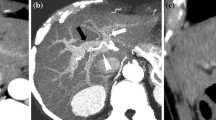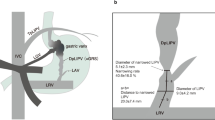Abstract
We carried out percutaneous transhepatic portography (PTP) in 182 patients with liver, biliary tract, or pancreatic disease. With anterior and lateral views of selective portograms and stereoscopic x-rays, we investigated the ramifications of the intrahepatic portal vein. There were 3 patterns of branching of the portal trunk and of the left branch of the portal vein. There were 8 such patterns for the right anterior branch, with either 4 or 5 major branches arising from it. Branching of the right posterior branch was classified into 4 patterns; simple branching into 2 (one, the posterior superior branch, the other, the posterior inferior branch) was found in only 97 of the 164 cases inspected. These results suggested that the liver cannot necessarily be divided into 8 segments. Branching of the intrahepatic portal vein is very complex; therefore, the pattern of ramifications of the portal vein must be ascertained anew for every patient for whom systematic segmentectomy is contemplated.
Résumé
Les auteurs ont pratiqué 182 portographies percutanées transhépatiques au cours d'affections du foie, des voies biliaires et du pancréas. En se basant sur des clichés antérieurs et latéraux, des portogrammes sélectionnés, ils ont étudié les ramifications intrahépatiques de la veine porte. Ils ont pu établir ainsi: que le tronc porte et sa branche gauche présentent 3 types de branches terminales; que la branche portale antérieure droite se divise suivant 8 modalités en donnant 4 ou 5 rameaux principaux; et que la branche portale postérieure droite se divise suivant 4 modalités, la modalité la plus simple c'est à dire la division en 2 rameaux principaux (branche postéro-supérieure et branche postérieure inférieure) n'ayant été retrouvé que chez 97 des 164 cas étudiés. Ces constatations indiquent que le foie n'est pas toujours constitué de 8 segments et que la ramification portale intrahépatique est très complexe. Il en résulte que le mode de ramification intrahépatique de la veine porte doit Être établie par portographie chez tout sujet qui doit Être soumis à une segmentectomie hépatique.
Resumen
Hemos realizado portografía percutánea transhepática (PPT) en 182 casos de enfermedad del hígado, del tracto biliar o del páncreas. Mediante el uso de proyecciones anterior y lateral, de portogramas selectivos y de radiografías estereoscópicas, procedimos a investigar las ramificaciones de la vena porta intrahepática. Se presentaron tres patrones de ramificaciones del tronco portal y de la rama izquierda de la vena porta. Se identificaron ocho de tales patrones para la rama anterior derecha, con 4 o 5 ramas principales originándose en ella. La ramificación de la rama posterior derecha fue clasificada en cuatro patrones; la simple ramificación en dos vasos (uno, la rama posterior y superior, el otro, la rama posterior e inferior) fue encontrada en sólo 97 de 164 casos inspeccionados. Estos resultados sugieren que el hígado puede no ser obligatoriamente dividido en 8 segmentos. La ramificación de la vena portal intrahepática es muy compleja. Es por ello que el patrón de ramificación de la vena porta debe ser establecido en cada paciente en quien se contemple realizar una segmentectomía sistemática.
Similar content being viewed by others
References
Mall, F.P.: A study of the structural unit of the liver. Am. J. Anat.5:227, 1906
Healey, J.E., Jr.: Clinical anatomic aspect of radical hepatic surgery. J. Int. Coll. Surg.22:542, 1954
Hobsley, M.: Intrahepatic anatomy-A surgical evaluation. Br. J. Surg.45:635, 1957
Couinaud, C.: Le Foie. Etudes Anatomiques et Chirurgicales. Paris, Masson, 1957, pp. 70–100
Gupta, S.C., Gupta, C.D., Arora, A.K.: Intrahepatic branching patterns of portal vein: A study by corrosion cast. Gastroenterology72:621, 1977
Bismuth, H.: Surgical anatomy and anatomical surgery of the liver. World J. Surg.6:3, 1982
Kinoshita, H.: Ultrasonically guided percutaneous transhepatic portography and its usefulness in surgery for primary carcinoma of the liver (in Japanese). Acta Hepatol. Jpn.23:892, 1982
Igawa, S., Kinoshita, H., Inoue, T.: Ultrasonically guided percutaneous transhepatic portogram in primary carcinoma of the liver (in Japanese). Jpn. J. Gastroenterol. Surg.16:45, 1983
Foley, W.D., Stewart, E.T., Milbrath, J.R., SanDretto, M., Milde, M.: Digital subtraction angiography of the portal venous system. Am. J. Radiol.140:497, 1983
Makuuchi, M., Hasegawa, H., Yamazaki, S.: Intraoperative ultrasonic examination for liver surgery and new concept in partial hepatectomy (in Japanese). Gekachiryo44:579, 1981
Kinoshita, H., Inoue, T.: A study on intrahepatic ramification of the portal vein appreciated by PTP (in Japanese). J. Med. Imagings3:69, 1983
Freeny, P.C.: Portal vein tumor thrombus: Demonstration by computed tomographic arteriography. J. Comput. Assist. Tomogr.4:263, 1980
Author information
Authors and Affiliations
Rights and permissions
About this article
Cite this article
Inoue, T., Kinoshita, H., Hirohashi, K. et al. Ramification of the intrahepatic portal vein identified by percutaneous transhepatic portography. World J. Surg. 10, 287–292 (1986). https://doi.org/10.1007/BF01658146
Issue Date:
DOI: https://doi.org/10.1007/BF01658146




